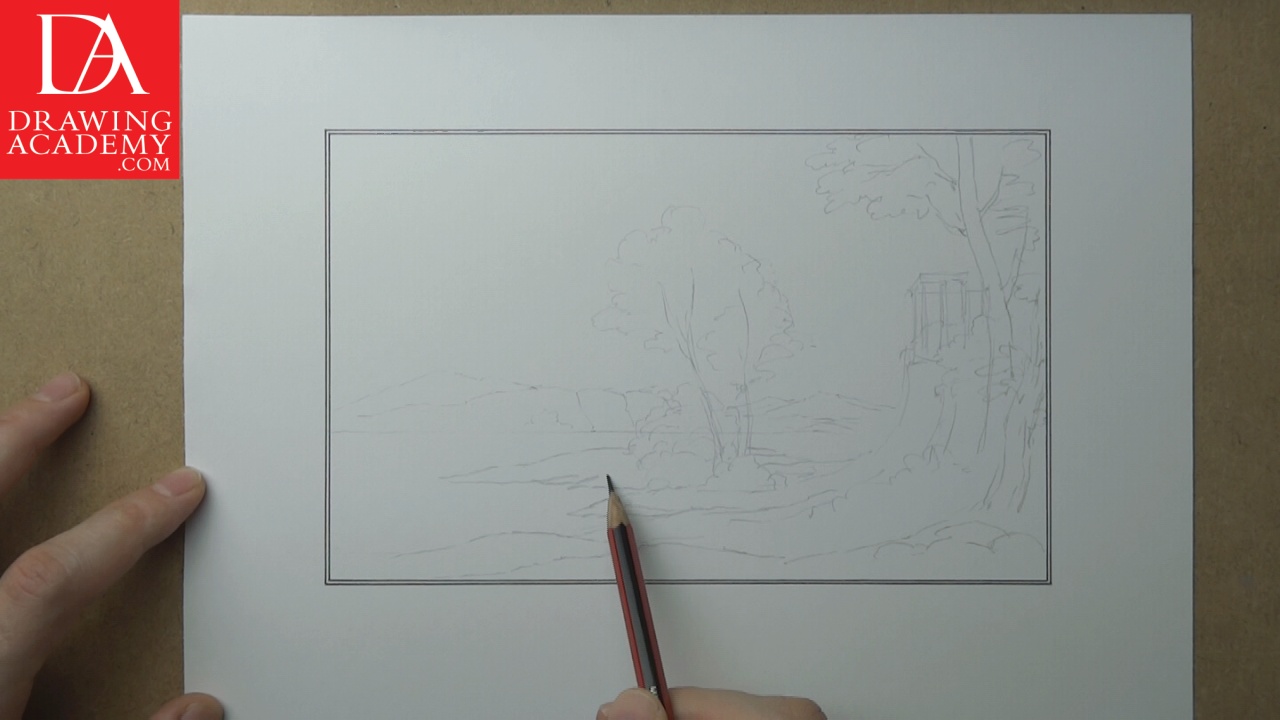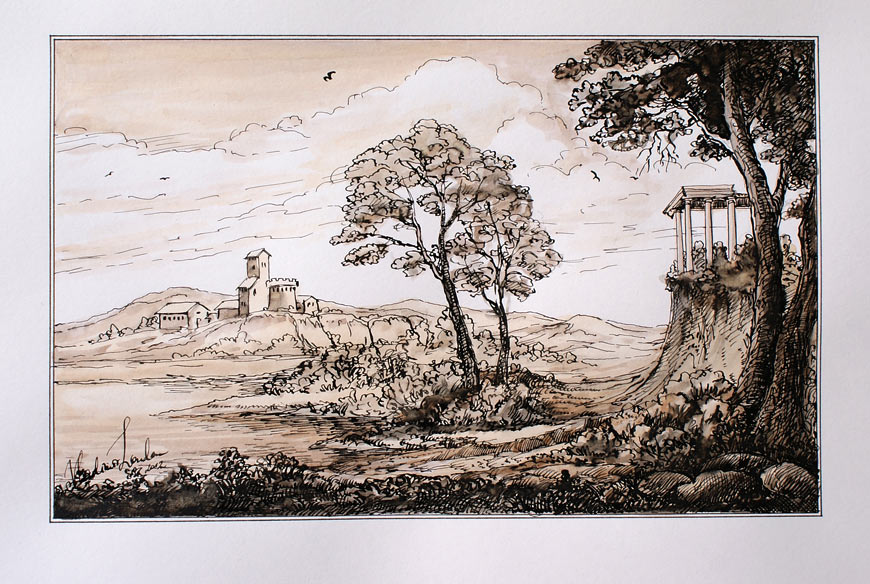Discover How to Draw a Landscape in Italian Style
In this video lesson you will discover How to Draw a Landscape in black and brown ink.
Enroll in the Drawing Academy Course
Pay once - Enjoy forever!
Only $297
Italian Style Landscape in Black and Brown Ink
This landscape is fictional and I drew it from my imagination. In this How to Draw a Landscape lesson, the style is loosely based on the Italian landscapes painted in the 17th-19th centuries. This landscape features a small town in the background, picturesque hills and the lake, stones, bushes and trees. The main point is the steep rock with classical architectural ruins on top of it.

When you think about “How to Draw a Landscape“, consider linear and aerial perspective. The rules of linear perspective apply to this drawing. The trees in the foreground appear very high because of linear perspective.
Trees in the middle are smaller on the drawing because they are located further away. The farther away objects are located, the smaller they look on the drawing.
This artwork is intended as an illustration and will have a certain degree of creative stylization.
How to Draw a Landscape – Rendering Details in Black Ink
In this “How to Draw a Landscape” lesson, the Leonardt England metal nib fixed in the wooden penholder is used. The black ink is Liquid Indian Ink by Windsor & Newton. This ink is water-soluble.

A good drawing requires a variety of lines. Lines must differ in length, direction, width and their form. Such range of lines is called, gamut. Fine drawings tend to have a wide but limited gamut. The variety in lines must have logic; there is no point in making a wide gamut just for the sake of it.
Considering the gamut of lines in this “How to Draw a Landscape” lesson, keep in mind that wide gamut makes an artwork more interesting. In this artwork, lines come in various lengths, angles, and closeness. They also emphasize the forms and texture of depicted objects.
For example, the bushes have small curved lines and dots representing their foliage. Lines of hills are curved and wavy, while lines of buildings are straight and angular.
The linear drawing gives movement and dynamics to the artwork. Having skills of linear drawing will help you to achieve greater results in tonal drawing, as well. A fine artist must attain virtuosity in hand drawing. Drawing is the foundation of all arts. Painting, sculpture and decorative arts are all based on good, professional drawing. That is why I included this “How to Draw a Landscape” into the Drawing Academy list of lessons.
Drawing in ink is one of the best practices to perfect your hand-drawing skills; it trains your eye as well.
In addition, drawing in ink also helps to develop the discipline and accuracy so required for professional fine artists. Fixing mistakes in ink is a challenging task. So, artists take more care to avoid them when drawing in ink. It is proven that artists who are good at ink drawing, make better decisions on the direction and quality of lines they do.
A trained hand makes precise lines and hatchings as intended by the artist. If you feel that your drawings come up inferior to what you had in mind, then you might consider having more practice in ink drawing.
If your ambition is to become a professional fine artist who can do graphical artworks for books and creative etchings, then practicing in ink drawing is a must. The clarity of ink drawing is very much suited for book illustrations. Having a well trained hand is very much required for etching making.
How to Draw a Landscape – Ink Lines and Dashes
Lines in ink must have gaps between them. Smaller gaps will produce a darker tone. You need to avoid such mistakes as placing lines too close to each other. A small distance between lines is less critical in graphite drawing; however, in ink, it might result in an appearance of blobs, which might spoil the artwork.
Short dashes and horizontal lines are good for depicting the landscape ground. Such marks change their direction from horizontal to vertical when we move from the ground to the upright rock. The direction of lines compliments and reveals the shape and form of objects. Short dashes and dots are used to portray the rock’s texture.




